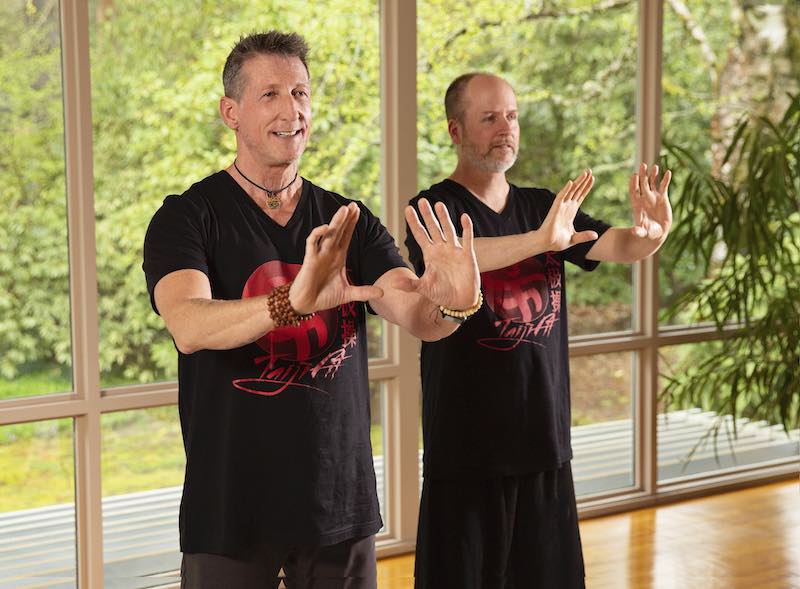Harvard Medical School says tai chi may be the best exercise for a healthy heart and cardiovascular system. I guide daily classes through easy follow-along healthy heart workouts using the beautiful and gentle movements of tai chi.
A healthy heart and circulatory system is so important because that's how oxygen is delivered throughout your body, and oxygen is the key ingredient to your metabolism. Poor circulation contributes to all kinds of adverse health conditions, like diabetes, arthritis, Alzheimers and stroke. In tai chi, it is understood that your blood, oxygen, and energy, or qi, circulate together and are the basis of your life. Raising your heart rate strengthens the heart, improves your vascular health, and raises your energy.
The American College of Sports Medicine says we need 30 minutes of continuous moderate-intensity motion to maintain basic cardiovascular health. Unlike most forms of exercise, tai chi movements use every part of your body all at once. This means for every minute you practice tai chi exercise, you're getting as much as four times the activity as in other workouts. And yet, it's gentle enough that even a beginner of any age or fitness level can develop a healthier heart with tai chi. And for an added bonus, you'll find that tai chi improves your mood and raises your spirit.
Strengthen Your Heart, Improve Your Circulation
"When Peter Wayne, medical editor of "Introduction to Tai Chi" from Harvard Medical School, began conducting scientific studies on the health benefits of tai chi, he began noticing that tai chi works in a variety of ways, not just one. Whereas most drugs have a single active ingredient, he observed that tai chi was more like a multi-drug combination that uses different components to produce a variety of effects.
Mind-body exercises, such as tai chi and yoga, have been gaining popularity over the past few decades. This is not surprising, given the increasing number of studies on the positive effects of these gentler forms of exercise—everything from lowering blood pressure and managing depression to building strength and improving balance. There is even evidence that tai chi may help you live a longer, more vital life.
Wayne formulated the idea of the "eight active ingredients" of tai chi, which he and his colleagues now use as a conceptual framework to help evaluate the clinical benefits of tai chi, explore the underlying mechanisms that produce these effects, and shape the way tai chi is taught to participants in clinical trials (and to teachers). While different styles of tai chi emphasize different ingredients, these therapeutic factors are interwoven and synergistic. Here's a summary of one of the active ingredients of tai chi.
Structural integration. Tai chi looks at the body as an interconnected system, not as a collection of individual parts. As a result, when practicing tai chi, you won't do one exercise for your biceps and another for your glutes. Instead, tai chi integrates the upper body with the lower body, the right side with the left side, and the extremities with the core. Alignment and posture are part of this structural integration, and tai chi trains you to find alignments that are safe and unstrained, allowing you to perform graceful movements. You move more efficiently—not just during your tai chi practice, but throughout your day. The result is less stress and load on your joints and better balance.
Improved posture provides tai chi benefits that extend well beyond your class. When you walk or sit with your shoulders rounded and your torso hunched over, it is hard to take deep breaths. But when you straighten your back, roll your shoulders back and down, and open your chest, you breathe more deeply and efficiently.
"Not only does this integration improve your ability to move without pain, but it also affects your mental health. In two different studies, people who sat or walked more upright during the experiments had a more positive outlook afterward than those who slouched while sitting or walking."— Harvard Medical School
The above is an original article by Master-Teacher David-Dorian Ross. He is author of many DVDs including his newest ones published by YMAA Publication Center, Tai Chi Fit: for Women ISBN: 9781594396915, Tai Chi Fit: Healthy Back: Seated Workout, ISBN: 9781594396946, and Tai Chi Fit: Healthy Heart Workout, ISBN: 9781594396922.







